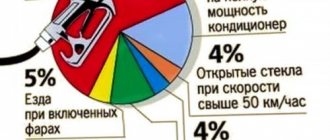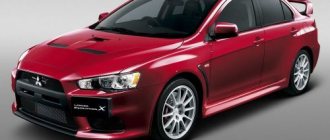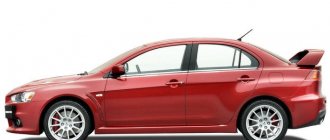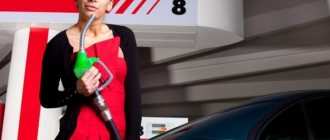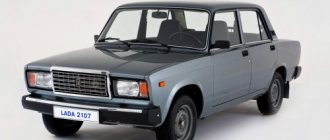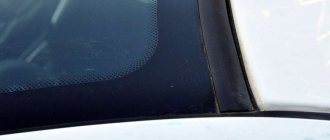Objective difficulties of fuel economy on the Niva-Chevrolet
The officially declared fuel consumption on the highway for the Chevrolet Niva is 8.80 l/100 km. In the summer, the actual consumption is close to the declared one, and with a smooth driving style without pressing the pedal “to the floor” and without sudden starts and braking, it is even a little lower. In winter it rises to 10.0 l/100 km. In the combined cycle, these values are 10.5 liters for “summer” and 13.3 liters for “winter”. In the city the figure reaches 14 liters.
Taking into account the fact that this car is an SUV and is intended for driving on rough terrain, during actual operation the average consumption is quite high.
When “driving off the road,” the driving style becomes suboptimal, and all-wheel drive is almost always engaged, and most often additional cargo is carried. As a rule, such a car is bought with the idea of using it for trips to the country, hunting, fishing or off-road tourist expeditions.
Therefore, experts who tell how to reduce fuel consumption on a Chevrolet Niva divide fuel saving solutions in this model into regulated and low-regulated ones. The second includes the design features of the car, on which fuel consumption depends, but which are difficult to influence.
- Motor design.
Car enthusiasts believe that the engine installed on the Niva-Chevrolet is morally outdated and simply cannot provide noticeable savings during operation even after improvement. General Motors made attempts to refine the engine by lightening the connecting rods and pistons, as well as reworking the cylinder block. Judging by the reviews, this made the car quieter, but not more economical.
Vehicle weight.
The heavier the car, the greater the fuel consumption, all other things being equal. On average, for every 100 additional kilograms of weight, consumption increases by 0.7-1.0 l/100 km. The Chevrolet Niva is a car weighing about 1.5 tons (which is quite a lot for its size) and is also functionally designed for transporting goods.
All-wheel drive and automatic transmission.
The energy-consuming functionality here comes into conflict with the idea of saving. If the main goal is fuel economy, then why buy an all-wheel drive SUV with an automatic transmission? In this case, it is more logical to immediately consider purchasing other models. Therefore, recommendations to “permanently disable all-wheel drive” or “switch” to manual transmission do not always seem correct - after all, the car was bought for ease of driving and reliability in overcoming obstacles.
Warming up
So, we have a Niva-Chevrolet SUV. How to reduce fuel consumption? You can reduce the car's appetite while the engine is warming up. Modern oils work even at very low temperatures, which means the engine will start and warm up while driving. Now there is no great need for long warm-up.
For carburetor versions, the pump can be upgraded. There are two tubes. One is longer, the other is shorter. The longer tube can be bent slightly, and it should be directed into the first chamber. Two jets will hit one point, and this way you can reduce consumption. For those who have an accelerator with one tube, you can purchase a repair kit for 2108 carburetors here. In this case, the dynamic characteristics are not affected.
For injection versions, you can purchase an on-board computer. A calmer, non-aggressive driving, movement according to the tachometer, competent switching - this is what definitely allows you to reduce consumption.
The 1.8-liter Opel engine has the best performance. With a power of 125 horsepower per 100 kilometers, it consumes:
- 12.7 liters in the city;
- 8.4 liters on the highway;
- 10.3 liters in the combined cycle.
Engines with a volume of 1.7 liters produced by AvtoVAZ are distinguished by higher consumption and lower power. The 82-horsepower Euro-5 engine consumes:
- 14.1 liters in the city;
- 8.8 liters on the highway;
- 11.2 liters in the combined cycle.
The outdated 1.7 liter engine model without auxiliary devices, which meets the Euro-2 environmental standard, consumes slightly less - 10.8 l/100 km in the combined cycle.
Oddly enough, you have to pay for environmental friendliness with high fuel consumption. But AvtoVAZ no longer supplies Opel engines, which at the same time save the owner’s wallet.
Regulating fuel consumption on Niva
When choosing less radical solutions, technical adjustments begin by considering the typical causes of high fuel consumption:
- determining the degree of friction in the braking system,
- front wheel adjustments,
- control over the thickness of the oil in the transmission,
- measuring the air pressure in tires (slightly overinflated tires - by 0.2 atmospheres - give a positive economic effect),
- checking the condition and clearance of spark plugs, high-voltage wires, cleanliness of injectors and filters.
The following savings methods specific to Niva are mentioned:
- Replacing the fan. Experiments by car enthusiasts have shown that the 6-blade Niva fan consumes about 0.7 l/100 km, which is 40% more than the 4-blade fan from the Zhiguli with 0.5 l/100 km.
- Replacing tires. “Niva” with “toothy” VLI-5 tires consumes 5% more of the total fuel consumption than with VLI-10 tires.
- Redirection of the accelerator pump to chamber 1.
- Installing and adjusting the position of the fuel needle in the carburetor needle and Unicar jets.
In a practical way, determining how to reduce fuel consumption on the Niva 21214, car enthusiasts experimented with driving at different speeds (injector, Bosch 7.0). So the consumption at 3000 rpm during acceleration was practically no different from acceleration at lower rpm. At a speed of 70-80 km/h on a flat road without acceleration, consumption was recorded at 8 l/100 km, which turned out to be 1 liter less than at speeds of 2000-2200. However, in this experiment and the subsequent discussion, the weighted average opinion came down to the fact that it is more economical to drive “pull” in any gear.
In assessing the low aerodynamics of this model, all car enthusiasts came to a unanimous opinion and the following conclusions:
- tuned cars (and Nivas are especially often weighted) consume more fuel,
- the upper (even empty) trunk increases consumption by 0.5 l/100 km,
Open car windows also significantly increase resistance, so to ventilate the interior without air conditioning, it is recommended to leave small gaps.
Option 2 of 4: Saving fuel
1. When refueling a car, do not fill the tank to the top. It is advisable that it be filled between half and quarter tank. And driving on an empty tank is very harmful to your car. The first thing that suffers is the fuel pump. And keep in mind, a tank filled with 60 liters increases the weight of the car by 45 kg.
2. When changing oil, give preference to synthetic, using additives. This reduces Niva consumption by approximately 15% (subject to the requirements of the instructions). Thanks to additives, the viscosity of the oil is stabilized, making engine operation smoother, because the lubrication process involves the entire volume of oil, and not part of it.
3. When choosing fuel, give preference to the best. Do not mix different types of fuel in one tank. Using cheaper gasoline allows you to save money, and the fact that cheap gasoline contains a large amount of ethanol indicates a significant overconsumption of fuel. As an experiment, you can fill up with the same amount of gas, determine which distance you can cover, and what is generally best for your car.
4. The use of synthetic oils will enable fuel savings of approx. by 5% . You should not ignore the scheduled oil change; this can result in excessive fuel consumption and damage to the engine. If for some reason you cannot use synthetic oil, then purchase the lightest one. For example, 5W-30 will have a greater effect than 15W-50. Watch how the engine behaves while driving. Sometimes engines running on synthetic oil run harder.
5. A significant increase in Niva consumption was noticed when using an air conditioner within the city. However, when driving on the highway in a car with air conditioning, fuel economy will be greater than with the windows open.
The air resistance when driving with the windows open is higher than the power consumed when using the air conditioning.
6. A visual assessment of fuel consumption can be given by knowing how loaded the engine is. Using air conditioning, sudden and frequent increases in speed, and traveling at high speeds have a serious impact on fuel consumption, but these are not the main indicators. Pay attention to engine speed. It's like monitoring your pulse by assessing your heart function.
By tracking the speed, decide at which engine performance is better . Engine speed above 3000 indicates a low gear. It is necessary to switch it and move at a higher speed, but at low speeds. Driving at medium speeds determines the Niva's consumption.
How to control engine speed? The dashboard of many cars is equipped with a device called a tachometer. Thanks to the tachometer, you can determine the engine speed at any time. The tachometer readings are reduced by 1 thousand times, i.e. if the arrow is against the number 3, then the engine operation is estimated at 3000 rpm.
The engine operates most efficiently in the range from 2000 to 3000, but in order to reduce fuel consumption, you should not cross the 2000 mark. You can only drive at engine speeds of more than 2700 when driving at top speed. This way you can travel around the city at a speed of 50-60 km/h and 105 km/h on the highway without fines.
see also
Comments 33
Press less in your slippers.
This is the problem - I can bench press less, but you can’t explain it to my wife, she benches as much as she wants
Chip as an option, consumption will drop, power will also drop if you are ready to make sacrifices and don’t want to sell the tires. When chippers do one thing, while other riders fall, this is the only option I see, other than switching to a regular city runabout.
a subcompact car is a definite no, they are small and low, but the family is growing and the roads are getting worse
Chip as an option, consumption will drop, power will also drop if you are ready to make sacrifices and don’t want to sell the tires. When chippers do one thing, while other riders fall, this is the only option I see, other than switching to a regular city runabout.
I changed the brain. There was an old factory firmware - Lilo 15 liters. Now the diagnostician promised 9-9.5 liters. the changes are felt - the ride is much better. I’ll also install a front axle disconnect switch on the transfer case, which should further reduce the consumption.
I wouldn’t recommend switching the traction to the rear axle, it’s not provided by the factory. At risk, plus they say it doesn’t slow down that much, the engine is already weak.
buy another car, sell the Shniva.
And what is the expense?
Having bought zhyp, they don’t cry for gasoline)))
That's right, Vova! Fak the fuel save! )))
Buy “Oka” and rejoice, 4 liters per 100
Switch to alternative types of fuel ;-) but in general, even without air flow sensor, consumption in the city is no more than 12 liters, provided everything else is in working order ;-) I don’t have a catalyst as a sensor for it
there is only one solution - Duster diesel
from 7.2 to 10.5 reasons million. 1. mass air flow sensor (MAF) - its condition. main! 2. control lambda probe (the first one immediately behind the manifold). 3. Gasoline is stolen or leaks. Jackie Chan glows? Sports ECM chip? the chain stretched out and moved the camshaft along the mark. gasoline 92 or 95?, tires (model (picture), how inflated, tubeless camera), spark plugs, explosive wires (northern lights?), trailer, handbrake? Is the lowering switch on? Is there anything sticking in the chassis? when the air intake was changed, the compression in the cylinders, the valve burned out, what is the condition of the catalytic converter cells? etc…
My city mileage is 11 and the catalyst is dying. Its removal and firmware will follow soon. The dynamics will improve a little.
If you fit within 15 and there are no errors of any kind, then it’s normal
I now have 15 in the city. But in the previous field it was 12. The driving style has not changed, which means there is definitely some problem. But how can you find it?((There are no errors. The consumption when warmed up on the computer shows 1 liter per hour. True, the last one had Yokohama AT tires, but this one has mudocords. But they can’t add 3 liters?
does it pull okay? the front calipers may become sour and consumption will increase noticeably
It seems normal. And the suspended wheels spin normally. I will try to change the sensors (mass air flow sensor, lambda). If it doesn’t help, I’ll change the ECU (or the firmware for that matter).
DMRV costs 4 rubles and lambda ruble... is it necessary? I would go to a smart diagnostician. There they will check your DMRV with a diagnostic tester and lambda.
I have everything left from a wrecked car (which had normal consumption), I won’t buy anything. But we have a problem with intelligent diagnosticians.
Fuel consumption Niva Chevrolet
Fuel consumption is an important issue for many SUV owners. Its volume depends not only on the cubic capacity of the engine, but also on the design features of the transmission, driving style or operating conditions.
Typically the manufacturer specifies average fuel consumption, but these values apply to “ideal” conditions.
The Chevrolet Niva is no different from its classmates in terms of efficiency, but when used correctly, it consumes fuel in moderate quantities.
In order to be able to compare this indicator and draw the right conclusions, you need to know the standard values and possible causes of excessive fuel consumption.
Normal fuel consumption 2123
The domestic SUV was developed on the basis of the classic Niva 2121, which traveled along the roads of the former USSR. Back then, gasoline was cheap and efficiency was not a primary goal.
Engineers sought to create a passable and maintainable car.
When releasing the modern Chevrolet Niva, significant changes were made to the fuel and air supply system. The car received an electronic control unit. This provided a more “moderate appetite” for the SUV. With a mixed cycle, 10.2 liters of fuel were consumed.
Dynamic characteristics
As follows from the data provided by the manufacturer, for the Niva-Chevrolet SUV, fuel consumption per 100 km on the highway is about 9 liters, in the city - about 14, in the combined cycle - about 11 liters.
Of course, engineers are trying in every possible way to reduce consumption. General Motors even made modifications to the engine. By lightening the connecting rods and pistons and reworking the cylinder block, the Niva turned out to be a little quieter, but it was not possible to reduce appetites. The motor is hopelessly outdated.
There is a way to reduce consumption, but it is not constructive. You just need to change your car. In 2015, engineers completely redesigned the Chevy Niva and now it has more dynamics, and maybe even lower fuel consumption.
What affects fuel consumption?
Economy is a variable value that depends on several factors. Increased fuel consumption may be due to improper operation of the vehicle or due to breakdowns of various types.
consumption on a Chevrolet Niva may vary depending on the following conditions:
- Time of year – consumption is always higher in winter. With a mixed cycle, this value can reach up to 13 liters, and in severe frosts more. This appetite is explained by an increase in the viscosity of the oil in the gearboxes, transfer case and gearbox.
- Gasoline quality - second-class fuel does not stay in the tank for long and is consumed faster. If you refuel at questionable stations, there is a risk of premature engine wear.
- Driving style – measured driving is more economical than sudden acceleration and braking. The less you fiddle with the gas pedal, the better.
- Tire pressure – more fuel is wasted on flat tires. The same indicator affects the speed limit. Therefore, check the pressure in the cylinders regularly.
- Expedition rack – cargo on the roof is +5% to fuel consumption. But if you choose a modern aerodynamic model, this value will be less.
- Selecting the transfer case mode - a lot of gasoline is wasted when the center lock is turned on. To avoid such cases, check the position of the lever regularly.
- Malfunctions - failure of the oxygen sensor, mass air flow, clogged injectors or air filter, air leaks in the air ducts, etc. These reasons can be eliminated yourself or in the service.
On the Internet, scammers offer to reduce gasoline consumption by up to 50% by installing “magnets” on fuel lines, including special sensors in the cigarette lighter, etc. You shouldn’t rush to believe in such promises; it’s better to think again and use logic.
How to reduce fuel consumption?
You can reduce fuel consumption to the values set by the manufacturer or 0.5-1 liters below the norm.
This can be achieved in the following ways:
- Choosing the right mode - with smooth acceleration and braking and driving at medium speeds, you will never have excessive fuel consumption. Select a gear depending on the type of road surface.
- Fill only with high-quality gasoline - at trusted gas stations that have confirmed their reputation. Don’t go for the cheap, remember: “the miser pays twice.”
- Carry out diagnostics regularly and timely service your vehicle. This will eliminate breakdowns and prevent problems in the power system. If necessary, visit a diagnostician periodically.
- Change the firmware - on models after restyling, you can remove the catalyst and change the software. This will increase power and reduce “appetite” by 10%.
Some “craftsmen” remove one of the cardans, which provides savings of up to 1.5 liters per 100 km. But during normal operation, the second gearbox wears out faster and will soon require repairs.
Warnings
Always maintain the required distance between your vehicle and the vehicle in front. If there is an obstacle and sudden braking, a collision may become inevitable.
Driving too slowly can also create an emergency situation. When driving on a motorway, you must pay attention to the minimum speed limit. If you don't adhere to it, i.e. if your car's speed is below the flow, you should have your hazard lights .
Some manufacturers are forced to waive warranties when the use of fuel and oil additives becomes known.
The presence of chip tuning and other car modifications can also void the warranty and also lead to engine failure in your car.
Do not believe charlatans and their reviews about a significant reduction in Niva consumption due to the use of miracle cures. Old scams return from time to time in an updated form, becoming a temptation for young and inexperienced drivers.
Is there an alternative?
To save fuel, some suggest converting to gas. There is a lot of debate on this issue, however, if you agree to such a rework, you should take into account the opinions of critics:
- It is not possible to repair the engine at every service center - for service you will have to visit a specialized workshop;
- gas consumption is higher - compared to gasoline, 1.5 times more fuel is required;
- burnout of the cylinder head gasket - the standard resource of 150 thousand km can be safely divided in half;
- gas takes away power, and Niva already doesn’t have enough of it;
- cross-country ability is reduced - if a gas cylinder is installed behind the rear gearbox, it noticeably reduces ground clearance.
Practice shows that HBO is not the best option for Niva. To increase cross-country ability, some try to place the cylinder in the trunk, but the container will take up its entire volume.
Adding to the complexity is increased engine wear and reduced vehicle performance.
Still, the best option for a Chevrolet Niva is high-quality gasoline and proper care.
What is the fuel consumption of the Chevrolet Niva per 100 km: reviews and real gasoline consumption, how to reduce it
The VAZ-2123 engine, which is the basis of Chevrolet Niva cars, was designed back in the 90s. Since then, the ECM on this engine has been updated several times, and a gradual transition from Euro-2 standards to Euro-5 has been made. Oddly enough, with each update, fuel consumption on the Chevrolet Niva increased. You can hear reviews that the 2005 engine consumes 10 liters per hundred, while for later versions the numbers go beyond 14. Well, let's try to understand the details.
The transition to Euro-5 standards is further described in the video. Let's see.
High fuel consumption: reasons
If the transmission components did not consume energy themselves, an all-wheel drive vehicle would be more economical than a single-wheel drive vehicle. Necessary conditions are non-disconnectable all-wheel drive and the presence of locking differentials. It seems that the Chevrolet Niva has all this.
What will happen in reality? If the front driveshaft is removed from the structure, fuel consumption will be 14.2 liters, and for the “standard version” the figures will be slightly worse - 14.8 liters per 100 km. All these figures were measured under the same conditions.
When it comes to significant weight and low tire pressure, practice really does match theory. For example, the Ural-375 all-terrain vehicle in the 6x6 version turns out to be more economical than with a 6x4 drive.
We can conclude that the energy consumed by the Chevrolet Niva transmission exceeds the losses caused by rolling friction in the tires. This is bad. However, for most light SUVs everything looks exactly the same.
Fuel consumption of Niva Chevrolet per 100 km according to the passport
Fuel consumption of AI-95 with Euro-2 engine, l/100 km:
- City – 10.8;
- Highway, 5th gear (90 km/h) – 8.6;
- Highway, 5th gear (120 km/h) – 11.6.
Now let’s study the figures typical for Euro-5 internal combustion engines and valid from 10/1/2015:
Progress bears fruit. Engine power remains the same, but fuel consumption per 100 km for the Chevrolet Niva increases.
All figures are published by the manufacturer himself. By the way, the air conditioner was not taken into account here.
According to reviews from owners, the official data is very close to reality - the difference is no more than 5%. Some people managed to “burn” 20 liters, but such cases must be dealt with separately.
How to reduce gasoline consumption?
There is unlikely to be a noticeable effect:
- From the use of “chemistry” (additives);
- From installing all kinds of “magnets”, etc.;
- Switching to “synthetics” (for example, 5W40) is a radical method, but not recommended;
- From the transition to AI-92, “liter consumption” increases slightly, consumption in rubles decreases.
To improve efficiency, you need to properly configure the transmission. People usually talk about balancing cardans, but know that imbalance can only occur as a result of deformation. There is no need to pay money for an almost useless procedure. However, let the owner make the final choice.
Balancing and correct installation of the RC
Everything is clear with shaft balancing, but other elements are usually not thought about.
Make sure you meet the following requirements:
- The transfer case (RK) is installed so that the axis of the gearbox shaft and the primary axis of the RK meet at a point coinciding with the center of the CV joint (see drawing). Also, the steering wheel must be centered: each secondary shaft must be parallel to the bottom and directed strictly along the body.
- The crosspieces should turn easily, and, moreover, with the same force!
- Avoid play in splines, crosspieces and secondary shaft bearings.
The tighter the crosspiece rotates, the more the steering wheel can deviate on its “pillows”. This results in noticeable energy losses.
Option 3 of 4: Driver Habits
1. Use cruise control driving technique. This often helps save fuel while maintaining a constant speed.
2. Don't rush. As the speed increases, the resistance of the oncoming air flow also increases. When driving at higher speeds, fuel consumption increases by up to 30%. At a speed not exceeding 60 km/h, the effect of air resistance on fuel consumption is practically non-existent, and at higher speeds it becomes more significant.
3. Sharp accelerations are very harmful. Internal combustion engines have an optimal operating mode at 2000-3000 rpm, and the greatest power develops at 5000-6000 rpm. When the engine reaches the required speed, you need to switch to the next gear using a manual gearbox.
For example, to accelerate a car to 50 km/h, you turn on the first, accelerate on the second, and then, skipping the third, turn on the fourth or fifth, provided the engine maintains speed. But you need to remember that when you press the gas pedal in fifth gear at low speed, there will be no acceleration. In this case, you can switch to a lower gear .
4. Try to brake as little as possible, because for subsequent acceleration you will use up fuel that could be saved. Carefully monitor the operation of traffic lights to avoid unnecessary acceleration.
5. You should not warm up the car while idling. It is better to do this by starting slowly, avoiding jerky accelerations until the engine reaches the required temperature.
6. Decide on the optimal speed in relation to the amount of fuel consumed. Often this is 80 km/h. Optimal speed involves minimum speed in maximum gear. For example, the optimal speed of Jeep Cherokees is 90 km/h, and Toyota 4Runners is 80 km/h . Determine the optimal speed of your car, try to stick to this speed when traveling.




